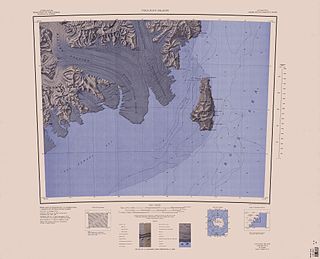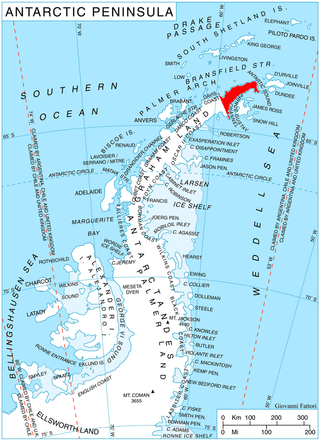Related Research Articles

The Arctic Archipelago, also known as the Canadian Arctic Archipelago, is an archipelago lying to the north of the Canadian continental mainland, excluding Greenland and Iceland.

Siple Island is a 110 km (68 mi) long snow-covered island lying east of Wrigley Gulf along the Getz Ice Shelf off Bakutis Coast of Marie Byrd Land, Antarctica. Its centre is located at 73°51′S125°50′W.

The Bastien Range is an Antarctic mountain range of moderate height which extends in a NW-SE direction for about 64 kilometres (40 mi), flanking the SW side of Nimitz Glacier and the Sentinel Range, in the Ellsworth Mountains.

Borchgrevink Glacier is a large glacier in the Victory Mountains, Victoria Land, draining south between Malta Plateau and Daniell Peninsula, and thence projecting into Glacier Strait, Ross Sea, as a floating glacier tongue, the Borchgrevink Glacier Tongue, just south of Cape Jones. It was named by the New Zealand Geological Survey Antarctic Expedition, 1957–58, for Carsten Borchgrevink, leader of the British Antarctic Expedition, 1898–1900. Borchgrevink visited the area in February 1900 and first observed the seaward portion of the glacier.
Ahlmann Ridge, also known as Ahlmannryggen, is a broad, mainly ice-covered ridge, about 110 km (70 mi) long, surmounted by scattered, low peaks. It rises between Schytt Glacier and Jutulstraumen Glacier and extends from Borg Massif northward to Fimbul Ice Shelf in Queen Maud Land. The area was first photographed from aircraft of the Third German Antarctic Expedition (1938–39) and peaks in this vicinity were roughly plotted. The Stein Nunataks and Witte Peaks, named by the German Antarctic Expedition, appear to coincide with the northeast part of the Ahlmann Ridge. The feature was mapped in detail from surveys and air photos by the Norwegian-British-Swedish Antarctic Expedition (NBSAE) (1949–1952) and air photos by the Norwegian expedition (1958–59). Named for Hans Wilhelmsson Ahlmann, chairman of the Swedish committee for the NBSAE.
Blümcke Knoll is a small steep-sided feature protruding through the ice of northern Adelaide Island, off the Antarctic Peninsula. It is about 11 nautical miles (20 km) southwest of Mount Velain.

Charles Glacier is a small, steep glacier draining the south side of Borg Mountain, in the Borg Massif of Queen Maud Land. It was mapped by Norwegian cartographers from surveys and from air photos by the Norwegian–British–Swedish Antarctic Expedition (NBSAE) (1949–52) and named for Charles W. Swithinbank, a glaciologist with NBSAE.

Olstad Glacier is a heavily crevassed glacier descending to the west coast of Peter I Island about 2 nautical miles (3.7 km) south of Tofte Glacier. Peter I Island was circumnavigated by the Norwegian whale catcher Odd I in January 1927 and was explored from the Norvegia in February 1929.
The Gruvleflesa Knolls are two low rock knolls rising above the Antarctic glacial moraine west of the Gruvletindane Crags, in the Kurze Mountains of Queen Maud Land. They were mapped from surveys and air photos by the Sixth Norwegian Antarctic Expedition (1956–60) and named Gruvleflesa.

Goff Glacier is a broad glacier flowing from Parker Peak into the head of Koether Inlet on the north side of Thurston Island, Antarctica. It was named by the Advisory Committee on Antarctic Names after Lieutenant Robert G. Goff, co-pilot of PBM Mariner aircraft in the Eastern Group of U.S. Navy Operation Highjump, which obtained aerial photographs of Thurston Island and adjacent coastal areas, 1946–47.

Hale Glacier is a glacier about 6 nautical miles (11 km) long, located just east of Mount Simpson on Thurston Island, Antarctica, and flowing southwest to the Abbot Ice Shelf in Peacock Sound. It was delineated from air photos taken by U.S. Navy Squadron VX-6 in January 1960, and was named by the Advisory Committee on Antarctic Names (US-ACAN) for Lieutenant Bill J. Hale, U.S. Navy, a helicopter pilot aboard USS Burton Island who made exploratory flights to Thurston Island in February 1960.

McNeile Glacier is a glacier flowing northward along the east slopes of Klokotnitsa Ridge to the southeast side of Almond Point where it enters Charcot Bay just east of Borovan Knoll, on the west side of Graham Land, Antarctica. It was charted in 1948 by the Falkland Islands Dependencies Survey (FIDS) and named for S.St.C. McNeile, a surveyor at the FIDS Hope Bay base in 1948–49.
Hushen Glacier is a glacier lying at the southwestern part of the base of the Mendelssohn Inlet, an inlet lying between Derocher Peninsula and Eroica Peninsula indenting the north face of Beethoven Peninsula, in the southwestern portion of Alexander Island, Antarctica. The glacier flows northeast while joining Reuning Glacier which discharges into the south part of Mendelssohn Inlet. It was mapped by the United States Geological Survey from U.S. Navy aerial photographs taken 1967–68 and from Landsat imagery taken 1972–73, and was named by the Advisory Committee on Antarctic Names for W. Timothy Hushen, Director of the Polar Research Board at the National Academy of Sciences, 1981–88.

Mahaffey Glacier is a glacier flowing into the head of Morgan Inlet at the east end of Thurston Island, Antarctica. It was named by the Advisory Committee on Antarctic Names after J.S. Mahaffey, a Photographer's Mate in the Eastern Group of U.S. Navy Operation Highjump, which obtained aerial photographs of Thurston Island and adjacent coastal areas in 1946–47.

Russell West Glacier is a glacier, 11 nautical miles (20 km) long and 4 nautical miles (7 km) wide, which lies immediately north of Detroit Plateau and flows from Mount Canicula, Verdikal Gap and Trajan Gate westward into Bone Bay on the north side of Trinity Peninsula. This glacier together with Russell East Glacier, which flows eastward into Prince Gustav Channel on the south side of Trinity Peninsula, form a through glacier across the north part of Antarctic Peninsula. It was first surveyed in 1946 by the Falkland Islands Dependencies Survey (FIDS). Named by the United Kingdom Antarctic Place-Names Committee (UK-APC) for V.I. Russell, surveyor and leader of the FIDS base at Hope Bay in 1946.
Reuning Glacier is a glacier situated on the north side of Beethoven Peninsula, lying within the southwest portion of Alexander Island, Antarctica. The glacier flows in a northwest direction and joins Hushen Glacier in discharging into south Mendelssohn Inlet. The glacier was first mapped by the United States Geological Survey (USGS) from U.S. Navy aerial photographs taken 1967-68 and U.S. Landsat imagery taken 1972–73. Named by Advisory Committee on Antarctic Names (US-ACAN) for Winifred M. Reuning, Office of Polar Programs, National Science Foundation (NSF), Editor, Antarctic Journal of the United States, from 1980 to 2015.
La Grange Nunataks is a scattered group of nunataks extending west for 22 nautical miles (41 km) from the mouth of Gordon Glacier, on the north side of the Shackleton Range, Antarctica. They were first mapped in 1957 by the Commonwealth Trans-Antarctic Expedition (CTAE), and were photographed in 1967 by U.S. Navy aircraft. They were named by the UK Antarctic Place-Names Committee for Johannes J. La Grange, a South African meteorologist with the CTAE.
Maria River, a watercourse of the Hastings River catchment, is located in the Mid North Coast region of New South Wales, Australia.
Colfax Township is a township in Grundy County, Iowa, US.
References
 This article incorporates public domain material from "Andenes Knoll". Geographic Names Information System . United States Geological Survey.
This article incorporates public domain material from "Andenes Knoll". Geographic Names Information System . United States Geological Survey.
